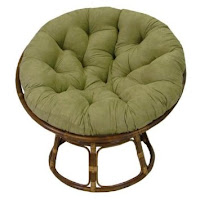A long wicker papasan chair, narrow plank that rests on two vertical axes: here is the ancestor of the chair, the bench. Although its origin is lost in the mists of time, we know well because it still builds the bench (or counter), albeit not so rough and primitive structure. The bench was originally spread throughout Europe and Asia, before the papasan chair several people, however, compelled to sit upright and uncomfortable. In the Renaissance Tuscan "bench dossal builds on foot to the back shelf and has fluted day built a series of elegant Ionic columns or by turned balusters. In the French specimens is called "Bank" and is a very solid rustic furniture that was placed in front of the fireplace where it was never even moved to a meal: it approached the dining table. The chair papasan is intended to accommodate one person is used at first only for priests and princes: it was indeed an aristocratic prerogative differentiate themselves from the crowd and sat apart, as if on a throne.
One of the first seat for one person, wicker papasan chair has the evocative name of "Faldistorio" and can be found in use as early as 1100. Derived from the "saddle Plicatilis" Lombard and Roman performed the nferro and rests on two pairs of cross-media mobile, united the upper end of one or more strips that hold the leather upholstery. The Faldistori carved wood and carved very rare, have a slight inflection in the shape of "S" from the double scissors (Very famous is still preserved in the wicker convent of Nonnberg near Salzburg, is decorated with carved ivory applications). The "chair" and "bench", typical elements of ecclesiastical furnishings have nothing to do with the chair itself, which appears in Europe in early 1400. The first Chair sticks or scissors probably arose from the fusion of the "Sella curulis" Roman chair with the field of Arab origin. A compromise between wicker papasan chair two types of civilization, characterized by a leader. They are constructed with a series of slats mounted on scissor pins, the back is made from a horizontal contour shaped tablet, where they're going to put on the ribs. In Tuscany, these wicker papasan chair specimens, which are preserved, with some variations throughout the 1500s, are called by the popular term for "iccasse" ie "X". In room Savonarola Florentine convent of San Marco can still see the chair in which he used to sit the militant friar is, in fact, the original "Savonarola" triggered by the "saddle Curulis" which repeats the typical structure "X". The Savonarola has a number of wooden slats, 8 to 12, curved coil and cross-scissor grafted foot down in a current and up to two right arms. The backbone consists of a shaped tablet stuck at the end of the arms and decorated wicker papasan chair with simple carvings.
Subscribe to:
Posts (Atom)

